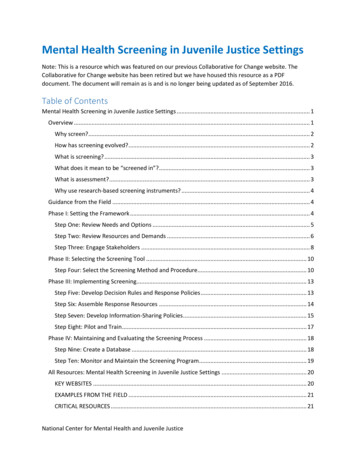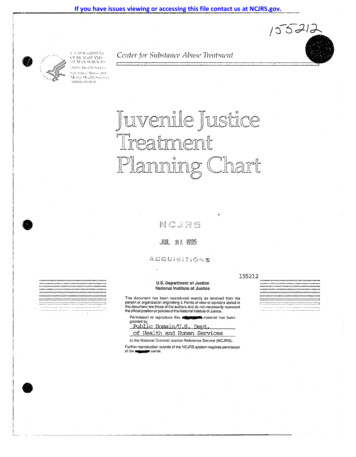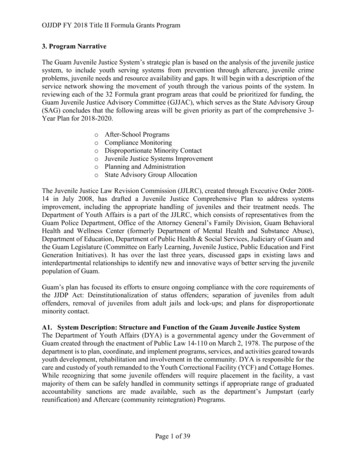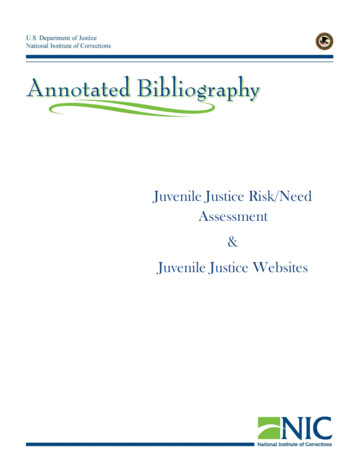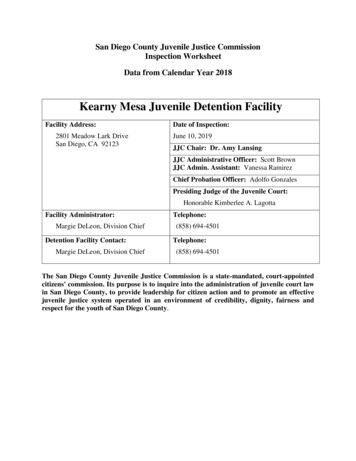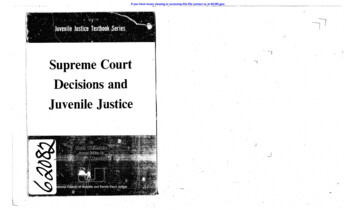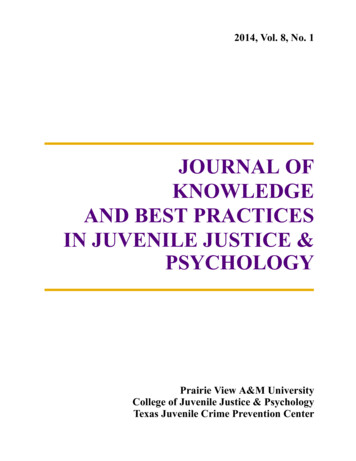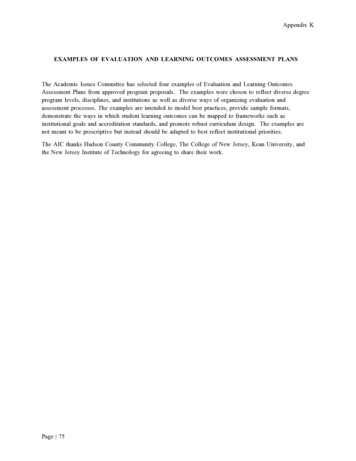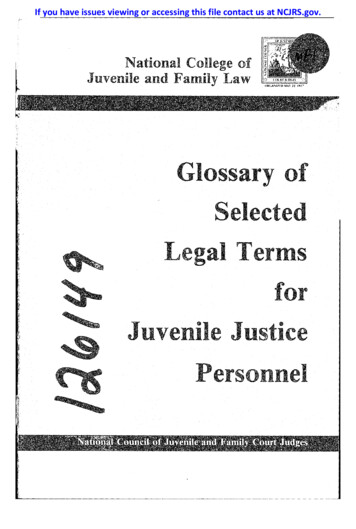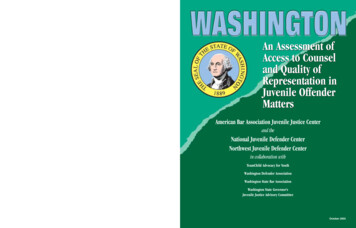
Transcription
An Assessment ofAccess to Counseland Quality ofRepresentation inJuvenile OffenderMattersAmerican Bar Association Juvenile Justice Centerand theNational Juvenile Defender CenterNorthwest Juvenile Defender Centerin collaboration withTeamChild Advocacy for YouthWashington Defender AssociationWashington State Bar AssociationWashington State Governor’sJuvenile Justice Advisory CommitteeAMERICAN BAR ASSOCIATIONOctober 2003
The preparation of this report was aided by the Office of Juvenile Justice, DSHS, through afederal grant from the Office of Juvenile Justice and Delinquency Prevention of the U.S. Department ofJustice, authorized under the Juvenile Justice, Runaway Youth, and Missing Children’s Act Amendmentsof 1982, through a grant approved by the Governor’s Juvenile Justice Advisory Committee.This project was supported by a grant from the Bureau of Justice Programs, U.S. Department of Justice.The Assistant Attorney General, Office of Justice Programs, coordinates the activities of the followingprogram offices and bureaus: Bureau of Justice Assistance, Bureau of Justice Statistics, National Institute ofJustice, Office of Juvenile Justice and Delinquency Prevention, and Office of Victims of Crime. Pointsof view or opinion contained within this document do not necessarily represent the official position orpolicies of the U.S. Department of Justice.This project was supported by Award Number 1999-JN-FX-0003, awarded by the Office of Juvenile Justice and Delinquency Prevention, Office of Justice Programs of the U.S. Department of Justice. The opinions, findings, conclusions and recommendations expressed in this publication are those of the authors anddo not necessarily reflect the views of the U.S. Department of Justice.The views expressed herein have not been approved by the House of Delegates or the Board of Governors of the American Bar Association and, accordingly, should not be construed as representing the policyof the American Bar Association.
WASHINGTONAn Assessment of Access to Counseland Quality of Representation inJuvenile Offender MattersWritten and Compiled by:Elizabeth M. Calvin, Esq.With the Assistance of:Elizabeth GladdenPatricia PuritzAmerican Bar AssociationJuvenile Justice CenterAmerican Bar AssociationCriminal Justice SectionJuvenile Justice Center
ACKNOWLEDGEMENTSThe state of Washington is fortunate to have many people deeply committed to the welfare of its children in trouble. Stakeholders from across the state,too numerous to list by name, gave advice and guidance to this project at eachstep of the way. Their opinions and insights inform the structure of the study, aswell as the analysis of the data and the recommendations for action.This project would not have been possible without the assistance of manypeople in Washington’s juvenile justice system. Judges, commissioners, defenders, prosecutors, probation officers, court administrators, detention staff, parents, youth advocates, social workers and youth generously shared their timeand provided their perspectives and experiences during the gathering of thedata that are the foundation of this report.This effort was also supported by a team of investigators, who work onbehalf of youth in the justice system, who donated their time and expertise tothis project, including:Janet Ainsworth, Esq.Associate Dean and Professor, Seattle University School of Law, WashingtonKim Ambrose, Esq.Supervising Attorney, Child AdvocacyClinic, University of Washington School ofLaw, WashingtonKelly H. Bartges, Esq.Director, Delinquency & Children’s LawClinic, University of Richmond School ofLaw, VirginiaKim Brooks, Esq.Executive Director, Children’s Law Center,Inc., KentuckyElizabeth M. Calvin, Esq.Former Executive Director, TeamChild;Consultant, Californiaiii
Jenny Carroll, Esq.Public Defender, The Defender Association,WashingtonBridgett Jones, Esq.Co-Deputy Director, Reclaiming Futures,OregonElizabeth MonroeAsher, Esq.The Law Offices of Elizabeth Monroe-Asher,WashingtonAnne Kysar, Esq.Associate Attorney, Schroeter, Goldmark &Bender, WashingtonCharlie Rosenberry, Esq.Contracted Counsel for juveniles in Washington state institutions, WashingtonSue Wood, MSWSocial Worker, Juvenile Division, AssociatedCounsel for the Accused, WashingtonSarah YatskoProgram Administrator, WashingtonDefender Association, WashingtonGeorge Yeannakis, Esq.Visiting Clinical Law Professor, PetersonLaw Clinic, Seattle University Law School,Washington.We offer special gratitude to Dr. Patricia McDonough, Professor at University of California Los Angeles, for her editing skills and insights into theanalysis of this study’s data.Finally, this project was doggedly, carefully, and persistently shepherdedfrom start to finish by a group of dedicated advocates for children, includingSimmie Baer, Christie Hedman and George Yeannakis. Hillary Behrman wasthe lead project advisor and instrumental in the development and implementation of the project as well as providing editorial assistance to the final report.Sarah Yatsko, as the Project Director, was the lead researcher on both the juvenile offender and Becca surveys, developed the written and onsite instruments,organized the interview process, analyzed the data and, along with KimAmbrose and Tracy Sarich, authored the Status Offender section.The Editorsiv
Table of ContentsEXECUTIVE SUMMARY . . . . . . . . . . . . . . . . . . . . . . . . . . . . . . . . . . .1INTRODUCTION . . . . . . . . . . . . . . . . . . . . . . . . . . . . . . . . . . . . . . . . . . .5CHAPTER ONEUnderstanding Juvenile Court . . . . . . . . . . . . . . . . . . . . . . . . . . . . . . . . . .11A. Washington’s Unique Juvenile Justice SystemB. How Washington’s Juvenile Justice System WorksC. Counsel for Children in Juvenile CourtD. The Critical Link to Effective Juvenile JusticeCHAPTER TWOFindings . . . . . . . . . . . . . . . . . . . . . . . . . . . . . . . . . . . . . . . . . . . . . . . . . . . . .21A. The Attorney/Client RelationshipB. Participation of Counsel in Juvenile Court ProceedingsC. Hearings: The Role of CounselD. Caseloads and AssignmentE. Training and Professional DevelopmentF. Inconsistency in the Quality of CounselG. Juvenile Defense SpecializationH. Racial DisproportionalityI. The Juvenile System as a Dumping GroundCHAPTER THREEVoices Rarely Heard: Insights From Youth . . . . . . . . . . . . . . . . . . . . . . .49CHAPTER FOURPrograms That Work . . . . . . . . . . . . . . . . . . . . . . . . . . . . . . . . . . . . . . . . . . .53CHAPTER FIVEConclusions & Recommendations . . . . . . . . . . . . . . . . . . . . . . . . . . . . . . .57Core RecommendationsPoints Of ActionAPPENDIXRepresentation of Status Offenders in Washington State Courts . . . .65ENDNOTES . . . . . . . . . . . . . . . . . . . . . . . . . . . . . . . . . . . . . . . . .77v
EXECUTIVE SUMMARY“I don’t feel like I have a chance to defend myself.Some attorneys try to help, some don’t.”Youth in detentionThe role of counsel for a child is a unique one for an attorney. Whendefending a young person against the accusation of a crime, there is no questionthat the lawyer’s role is first that of criminal defense attorney. The attorneymust know criminal law and procedure, and must follow the rules of professional conduct. But representing a young person stretches the role of the attorney. These clients are less able to defend themselves than the typical adultclient. Their stage of development may not include effective tools for decisionmaking. They are more likely than the general population to have learning disabilities and mental health problems, and are more likely to be the victims ofneglect and abuse. They are, in a word, vulnerable.The juvenile justice system has many components, but a key player, andarguably the person with the closest relationship to the children who enter juvenile court, is the attorney who represents them. Juvenile defenders are in aunique position not only to protect children’s rights, but also to create positiveoutcomes in their lives. This report examines the quality of representation ofchildren in Washington state, with a specific focus on offender matters.BackgroundThe first systematic national assessment of the role of children’s counselwas conducted in 1995 by the American Bar Association Juvenile Justice Center(ABA) in collaboration with the Youth Law Center and Juvenile Law Center.The findings were published in A Call for Justice: An Assessment of Access toCounsel and Quality of Representation in Delinquency Proceedings. This reportfound that despite the high stakes involved in today’s juvenile court proceedings, many children still fail to receive effective legal representation. A Call forJustice encouraged individual states to assess their own indigent juvenile1
2Juvenile defenders are in aunique position not only toprotect children’s rights,but also to create positiveoutcomes in their lives.WASHINGTONdefense systems. Since that time, assessments have been conducted in Georgia,Kentucky, Louisiana, Maine, Maryland, Montana, North Carolina, Ohio,Pennsylvania, Texas, Virginia, and Washington to analyze state-specific policiesand practices. Several other states are in the preliminary stages of the assessment process.A Call for Justice was, in part, what inspired Washington citizens to examinethis state’s juvenile indigent defense system. Juvenile justice leaders started thisstate’s assessment in 2002, as a collaborative effort of the Governor’s JuvenileJustice Advisory Committee, TeamChild, the Washington Defender Association, the Washington State Bar Association, and the Northwest JuvenileDefender Center in partnership with the ABA. Funding was provided by theWashington Defender Association, the Governor’s Juvenile Justice AdvisoryCommittee, the Northwest Juvenile Defender Center, and National JuvenileDefender Center of the ABA. The collaborative effort became known as theWashington Juvenile Justice Assessment Project (WJJAP).MethodologyThe primary goal of this study is to evaluate the quality of counsel defending children in Washington’s juvenile courts. Stakeholders from across the statewere invited to participate in defining the objectives of WJJAP, includingjudges, prosecutors, defense attorneys, bar association leaders, university professors, social scientists, child welfare providers, civil legal service attorneysand others with experience in juvenile court.Approximately 40 people attended the initial stakeholders meeting and discussed the goals of the project. Others provided input via email and telephonecalls. The ABA set basic guidelines for the collection of data, and the stakeholders helped define the collection parameters. The decision was made to collectdata in both face-to-face interviews and written surveys. With a goal of ensuring a representative mix of data, a variety of factors, including population size,income levels, racial statistics, geographic factors and diversity of types ofpublic defense systems, were used to select six counties for site visits.Over 200 in-person interviews of judges, commissioners, prosecutors, probation officers, detention staff, defense attorneys, court administrators, socialworkers, advocates, parents and youth were conducted across the state byexperienced, investigative teams of juvenile justice professionals. In most cases,each team consisted of two professionals, one from Washington and one fromoutside the state.The findings in this report were also based on written surveys mailed to 230juvenile defenders in all 39 counties across the state. The 300 question surveywas written by WJJAP staff, with input from both the WJJAP advisory committee and the ABA. A beta test of the survey was performed, and some questionswere changed based on the feedback. Nearly 100 written surveys from 33 counties in the state were completed and returned, providing invaluable information for this report.
Executive SummaryKey Findings Most Washington counties have not adopted public defense standards, as required by state law. As a result, the quality of defense isinconsistent and unpredictable.Across the state, caseloads violate accepted standards of practice.High caseloads are reducing the quality of representation.There is no comprehensive and regular training or supervision ofattorneys in most jurisdictions. In only a few locations do attorneysget regular performance reviews.Children with problems that should be treated elsewhere often endup in the juvenile court system, and defenders often fail to adequately help their clients with mental health concerns and otherserious problems.In Washington state, children are represented by counsel at mostjuvenile court proceedings. However, some counties do not everprovide counsel at probable cause hearings, and, in some counties,young people go forward in a variety of hearings without the assistance of counsel.In direct conflict with national standards, Washington law permitschildren to waive their right to counsel.There is confusion and disagreement about the role of juveniledefenders and, as a result, important opportunities to effectivelycounsel and represent the interests of the child are lost.Although in some counties defenders are perceived by judges andothers as well-prepared for court, in many counties, motions andtrials are rarely brought, independent investigation of cases is rareand only takes place in more serious cases, and defenders are notfully prepared for disposition (sentencing) hearings.In Washington state, defenders seldom assist clients after the juvenile court case is concluded, even to make referrals for neededservices.Core Recommendations Children should be represented by effective counsel at all courthearings, including probable cause hearings. Effective representation of children requires adequate time to meet with and counselclients, and it requires support services, including investigation,access to independent experts, interpreters, evaluation and socialwork.Washington law should be changed to conform to national standards prohibiting children from waiving the right to counsel. Untilthe law is changed, the judicial colloquy with youth regarding theirdecisions to waive counsel should be thorough, comprehensive,and easily understood.3
4WASHINGTON Continuity of representation should continue to be supported andenforced throughout the state. Counsel should represent a childthroughout a case, including probation violations. If the child hasnew offender matters, the same attorney should be assigned to represent the child.Every county should enact standards of practice as mandated byRCW 10.101.030. Standards should include attorney qualifications,caseload limits, supervision, training and regular performancereviews. The adequacy and implementation of county standardsshould be assessed by an independent body. The standardsendorsed by the Washington State Bar Association, the Institute ofJudicial Administration, and the American Bar Association shouldserve as guidelines for the enactment of such standards.A state ombudsman office should be created and funded to addresscomplaints concerning delivery of public defense services.Attorneys should participate in comprehensive training beforestarting to represent any child and should have the opportunity toparticipate in ongoing training specific to the representation of children.Attorney caseload limits should be set by each county contractingfor public defense services. Caseload limits should reflect the standards endorsed by the Washington State Bar Association.Law schools should develop focus areas in the representation ofchildren. Washington should lead the nation in establishing LLMor other certificated programs for a child legal advocacy specialty.
INTRODUCTION“When I approach a child, he inspires in me two sentiments;tenderness for what he is, and respect for what he may become.”Louis PasteurDespite the fact that Washington State juvenile arrest rates for violentcrime are now at their lowest point since 1982, the public still appears to perceive juvenile crime to be a major problem. “Stop Juvenile Violence!” declarebumper stickers, implying juveniles are the main source of violence and crimein our society. There are currently a number of different efforts to look behindthe crime and at our systems of justice to determine whether more can be doneto lower the rate of crime. If we start with the idea that the juvenile justice system can be, in part, a place of opportunity to help children in trouble, we canlook for ways to address the roots of delinquent behavior, instead of justresponding to repeated offenses. The juvenile justice system has many components, but a key player, and arguably the person with the closest relationship tothe children who enter juvenile court, is the attorney who represents them.Juvenile defenders are, therefore, in a unique position not only to protect children’s rights, but also to create positive outcomes in their lives. This reportexamines the quality of representation of children in Washington state, with aspecific focus on offender matters.In many ways, this report literally speaks for itself—the voices of youth,juvenile defenders, judges, probation officers and a range of other juvenilecourt personnel tell the story of Washington’s juvenile indigent defense system.The viewpoints are many, diverse, and insightful. A picture emerges of anuneven system with shortcomings that have a particularly devastating impacton children. It raises questions as to whether court-involved youth are beingprovided the legal services to which they are entitled. Yet, despite these failings,the findings also identify model and exemplary practices—lawyers who fullyembrace their ethical obligation to zealously represent their child client.5
6WASHINGTONA. THE ORIGINS OF JUVENILE COURTIn a system of justicefor children, we neednot choose betweenrehabilitation anddue process rights.Before America’s juvenile court system was established more than one hundred years ago, children accused of crimes were treated like adults. They facedthe same adult penalties in the same adult prisons. They had virtually noopportunity for rehabilitation. In 1889, a group of visionary women in Chicagocreated a new court system just for children focused on rehabilitation. The U.S.Supreme Court described the founders of the first juvenile court as “profoundlyconvinced that society’s duty [to a child accused of a crime] could not be confined to the concept of justice alone.” They believed that society’s role was notto ascertain whether the child was “guilty” or “innocent,” but “what is he, howhas he become what he is, and what had best be done in his interest and in theinterest of the state to save him from a downward career.”1In the early part of the twentieth century, states established juvenile courtsacross the country. For nearly 70 years, a system of parens patriae prevailed inwhich the juvenile court took on the role of parent and made decisionsbased on the judge’s view of the best interest of the child. Summarizing thefirst juvenile court, the U.S. Supreme Court noted that the child “was tobe made ‘to feel that he was the object of [the state’s] care and solicitude,’ notthat he was under arrest or on trial. The rules of criminal procedure were,therefore, altogether inapplicable The idea of crime and punishment was tobe abandoned.”2While juvenile courts purported to be caring and solicitous, children faced areal loss of liberty—just like adults in criminal court—but without the protections that limit the abuse of unbridled authority. Hence, a false dichotomyplagued the original juvenile court system. It was as if there were only two,mutually exclusive choices for a juvenile justice system: either one thataddressed the needs and potential of young people or one that maintained constitutional safeguards of due process. Supreme Court Justice Stewart summedup the two perspectives, “The object of one is correction of a condition. Theobject of the other is conviction and punishment for a criminal act.”3The tide turned in 1967 when the U.S. Supreme Court reviewed the practices of juvenile delinquency proceedings in In Re Gault. The Court observedthat, “Juvenile court history has again demonstrated that unbridled discretion,however benevolently motivated, is frequently a poor substitute for principleand procedure.”4 The Court concluded that “[N]either the Fourteenth Amendment nor the Bill of Rights is for adults alone. Under our Constitution the condition of being a boy does not justify a kangaroo court.”5 Explicitly extendingfederal constitutional protections to children in juvenile delinquency proceedings, In re Gault guaranteed children accused of crimes the right to counsel,notice of charges, confrontation, cross examination, appellate review, a transcript of proceedings, and the privilege against self-incrimination.At the same time, the Supreme Court acknowledged the existence of thefalse rehabilitation-versus-rights dichotomy and set forth a new expectationthat juvenile court encompass both ideals. In a system of justice for children, weneed not choose between rehabilitation and due process rights. “[T]he observance of due process standards, intelligently and not ruthlessly administered,will not compel the States to abandon or displace the substantive benefits of thejuvenile justice system.”6 Yet, more than 36 years after this landmark decision,
Introduction7this false dichotomy continues to insinuate itself into the workings of juvenilecourt, often blurring the goals of the juvenile justice system.7B. A CALL FOR JUSTICEIn the years following In re Gault, multiple efforts were made to set standardsfor the juvenile justice system, each having a particular emphasis on the role ofcounsel representing children in delinquency proceedings and the need to safeguard children’s rights.8 In 1974, Congress enacted the Juvenile Justice Delinquency Prevention Act (JJDPA)9 which authorized the creation of a NationalAdvisory Committee for Juvenile Justice and Delinquency Prevention (NAC) todevelop national juvenile justice standards. Published in 1974, the NAC’s standards require that children be represented by counsel at all juvenile delinquencyproceedings, beginning at the earliest stage of the decisional process.10Beginning in 1971, over a ten year period, approximately 300 professionalsthroughout the nation, including prominent representatives of every disciplineconnected to the juvenile justice system: the law, the judiciary, medicine, socialwork, psychiatry, psychology, sociology, corrections, political science, lawenforcement, education, and architecture, wrote a 23 volume set of juvenile justice standards. The work was done under the auspices of the Institute for Judicial Administration/American Bar Association Joint Commission on JuvenileJustice Standards.11 By 1981, 20 of these volumes had been adopted in full by theAmerican Bar Association House of Delegates.In 1992, Congress reauthorized the JJDP Act, again emphasizing the crucialrole of lawyers for children in delinquency proceedings, particularly given theinadequacies of prosecutorial and public defender offices to provide individualized justice.In 1993, the American Bar Association Juvenile Justice Center, in conjunction with the Youth Law Center and Juvenile Law Center, received fundingfrom the federal Office of Juvenile Justice and Delinquency Prevention to initiate the Due Process Advocacy Project. The purpose of the project was to buildthe capacity and effectiveness of juvenile defenders through increasing accessto lawyers for young people in delinquency proceedings and enhancing thequality of representation those lawyers provide. One result of this project wasthe release of A Call for Justice: An Assessment of Access to Counsel and Quality ofRepresentation Proceedings in 1995,12 the first systematic national assessment ofcurrent practices of juvenile defense attorneys.The report examined the gaps in the quality of legal representation for children. It noted that some attorneys vigorously and enthusiastically representtheir clients, but also raised serious concerns that such representation is neitherwidespread, nor common. The centennial of the founding of the first juvenilecourt in 1999 prompted many people concerned about justice for children to reexamine the process by which legal services are provided to indigent children.A state-by-state assessment of juvenile defense systems has begun. At the timeof this writing, juvenile defender assessments have been conducted in Georgia,Kentucky (an assessment and a re-assessment one year later), Louisiana, Maine,Maryland, Montana, North Carolina, Ohio, Pennsylvania, Texas, Virginia, andWashington to analyze state-specific policies and practices. Several other statesare in the preliminary stages of the assessment process.The centennial of thefounding of the firstjuvenile court in 1999prompted many peopleconcerned about justicefor children to re-examinethe process by whichlegal services are providedto indigent children.
8WASHINGTONC. METHODOLOGYIn 2002, leaders in Washington state began an examination of their own.They formed the Washington Juvenile Justice Assessment Project (WWJAP) toassess the quality of representation for juveniles in their justice system. WJJAP’sfirst step was to secure input from a wide group of stakeholders. Invitations toparticipate were sent to judges, prosecutors, defense attorneys, bar associationleaders, university professors, social scientists, child welfare providers, civillegal service attorneys and others with experience in juvenile court. Approximately 40 people attended the initial stakeholders meeting and discussed thegoals of the project. The ABA set basic guidelines for the collection of data, andthe stakeholders helped define the collection parameters. The decision wasmade to conduct comprehensive site visits and to obtain additional datathrough interview and statewide surveys. With a goal of ensuring a representative mix of data, a variety of factors, including population size, income levels,racial statistics, geographic factors and diversity of types of public defendersystems, were used to select six counties for site visits.13Experienced, investigative teams of juvenile justice professionals wereselected for each onsite visit. In most counties, the team consisted of one personfrom Washington (but not from the site where he or she would be interviewing)and another person from outside of the state. While many of the investigatorswere attorneys, there were also law professors, social workers, directors of nonprofit agencies, a foundation administrator, and public defender supervisors.All were well-acquainted with the role of attorneys in juvenile court, havingeither practiced in juvenile court or having published on juvenile justice issues.Having been briefed on basic background, demographics, and other general information about the county, investigators visited each site to conductinterviews (pursuant to standardized ABA protocols), observe judicial proceedings, and gather documentary evidence. After spending at least two full days ateach site, investigators submitted reports with their findings.Juvenile justice personnel and stakeholders interviewed included: Commissioners and JudgesCourt administratorsDefense attorneysDetention staffParentsProbation OfficersProsecutorsYouthSeveral weeks prior to each site visit, those to be interviewed were given anoverview of the project and opportunities to ask questions. Given the importance of candor to this report, interviewees were promised anonymity. Individual and county names were excluded, and other identifying factors, such asgender, population, or demographics, were purposely removed from the datain this report.
IntroductionThe findings in this report were also based on written surveys mailed to 230juvenile defenders in all 39 counties across the state. The 300 question surveywas written by WJJAP staff, with input from both the WJJAP advisory committee and the ABA. A beta test of the survey was performed, and some questionschanged based on feedback.Defenders in 33 of the state’s 39 counties completed and returned the survey. With 30 letters returned for either incorrect address or some indication thatthe attorney did not practice in juvenile court, there was a final response rate of46%—93 out of 200 completed the survey. Both status offender and juvenileoffender surveys were sent to each attorney. The rate of return for the two surveys is as follows: 74 attorneys completed an offender survey; 39 attorneyscompleted a status offender survey; 20 attorneys having completed both a status offender and an offender survey.The status offender data, much less comprehensive than that collected onthe representation of offenders, is presented in the Appendix.The data are summarized in Chapter Two. The findings were then reviewedby the stakeholder group, which devised recommendations for action presented in Chapter Five.9
CHAPTER ONEUnderstanding Juvenile Court“There can be no keener revelation of a society’s soul than the wayin which it treats its children.”Nelson MandelaA. WASHINGTON’S UNIQUE JUVENILE JUSTICE SYSTEMAt the turn of the century, Washington state was an “early and enthusias-tic convert to the rehabilitative ideal and indeterminacy,” and its criminal justice laws provided “wide and unconstrained discretion to judges andcorrectional officials.”14 Washington first enacted a juvenile code in 1913 thatwas solidly within the parens patriae philosophy of rehabilitation through“benevolent coercion.”15 That law remained in effect without major changesuntil 1977.16In the period following In re Gault, Washington struggled to reform its juvenile justice system. Nearly a decade passed before the Washington State legislature enacted the Juvenile Justice Act of 1977 (JJA).17 While Washington’s act wasmodeled af
Justice, authorized under the Juvenile Justice, Runaway Youth, and Missing Children's Act Amendments of 1982, through a grant approved by the Governor's Juvenile Justice Advisory Committee. This project was supported by a grant from the Bureau of Justice Programs, U.S. Department of Justice.


